Odds & Ends: War of the Spark
I always do a mailbag column when each new set comes out. It's time for me to answer some questions from all of you about War of the Spark.
Here's the tweet I put out:
It's time for me to write a mailbag column or two about #mtgwar.>#WotCStaff — Mark Rosewater (@maro254) April 12, 2019
As always, I'll try to answer as many questions as I can, but here's why I might not answer your question:
- I have an allotted word count, which means that there are only so many questions I can get to.
- Someone else might have asked the same question. I will usually answer the first person who asks.
- Some questions I either don't know the answer to or don't feel qualified enough in the area to properly answer.
- Some topics I'm not allowed to answer for all sorts of reasons, including previews for future sets.
As has become tradition, I'm going to start with the most asked question:
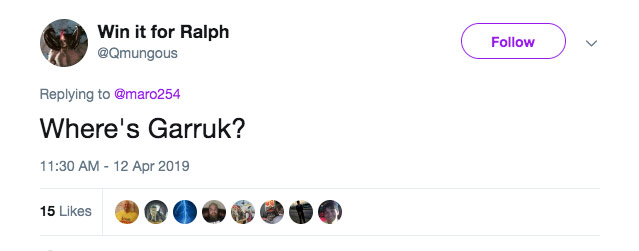

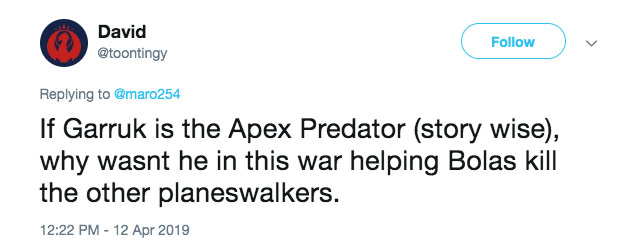
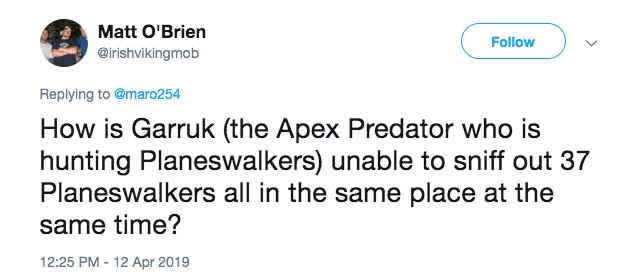

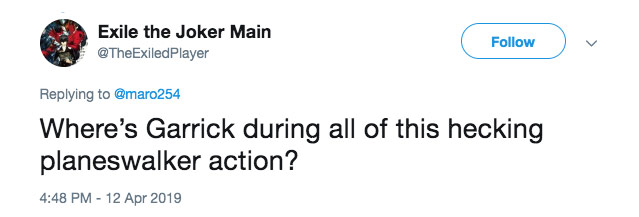
Where was Garruk? Why in the world wasn't Garruk in War of the Spark? There are two answers to this question, one real world–based and one in-story. I'll start with the former. Garruk is a popular character, and we have a story we want to tell with him. Magic has a lot of Planeswalkers, and we're trying to balance giving as many as we can some time in the spotlight. That does mean some characters have to wait for their turn. The storyline we want to tell with Garruk just didn't line up with the Bolas Arc. For a while, Garruk showed up in Dominaria, but the way we had to twist things to make that work just didn't let us tell the Garruk story we want to tell. As I've said before, we have plans for Garruk, and you all will see him again. War of the Spark just wasn't the right fit.
In-story, Bolas's plan was to lure as many Planeswalkers to Ravnica as possible so that his Dreadhorde army could harvest their Sparks (incidentally killing them, but that wasn't Bolas's primary concern). Garruk is a very efficient Planeswalker hunter. The last thing Bolas wanted was to gather all these Planeswalkers in one place and then have Garruk slaughter a bunch of them before he could harvest their Sparks. That means, as Bolas was doing all his plotting to make sure as many Planeswalkers came to Ravnica as possible, he also had to spend some energy specifically making sure Garruk didn't show up.

Another Planeswalker I've gotten a lot of questions about is Dack Fayden. Unlike Garruk, Dack Fayden is part of the story. He's one of the eleven narrators of the War of the Spark novel. Why, then, doesn't Dack show up on a card in War of the Spark? I'll give you the answer, but I'll warn you up front that it's not a very satisfying one. It has to do with some behind-the-scenes issues that we normally try not to put a spotlight on. (Ideally, we want Magic to feel like one seamless product.)
Let's start with a blunt truth. There's simply no way to write the story at the same time as we design the set. Each involves iteration, and you can't have two constantly changing things keep in sync with one another. One of them has to finish, locking itself down, so that the other can adapt to it. Story is infinitely more flexible than card design, so it makes sense to have the card design go first. Note that work is done to flesh out the broader strokes of the story before design begins, so design has something to aim toward, but it's more the larger story beats and less the smaller character moments.
This meant going into War of the Spark design, we knew the basic story—we knew who was fighting who, the outline of the battle, and how it was going to resolve. A lot of our design was done to make sure the set would be able to communicate many of these broad story moments in the cards. When author Greg Weisman set out to write the War of the Spark novel, he had the larger story beats and access to what was showing up on various cards. While he used as many of the existing elements as he could, part of writing a story is finding natural beats that come from the story you're trying to tell. The set was missing something he needed.
So, Greg talked with people at Wizards and worked through what he needed to tell his story. As much as possible was pulled from things already in the set, but this one storyline needed a Planeswalker, and none of the ones in the set were the right fit. After looking at the many Planeswalkers not in the story, it turned out Dack Fayden was the perfect choice. There was no reason Dack couldn't be on Ravnica from a story perspective. In fact, Dack had even been a card during vision design but had gotten removed when we decided that Saheeli better fit the set constraints than Dack. (Ral was a rare blue-red planeswalker, leaving only the uncommon hybrid slot for a second one.)
By the time we realized Dack was playing a larger role in the story, it was just too late to change the cards. Saheeli's card didn't make any sense as Dack. It made 1/1 Servos (creatures specifically from Kaladesh) and turned artifacts into a copy of other artifacts or creatures, a very Saheeli ability. (Dack, in contrast, steals artifacts.) Limited was balanced, so we also didn't want to just switch an uncommon. The other slot to put him in was Ral Zarek's slot at rare, but Ral plays a big part in the story and needed to be there. There was no other duplication of two-color planeswalker slots at rare, so we couldn't just fit him in elsewhere. Also, it's quite possible the stained-glass video had already started work, which would have caused additional problems. (Ironically, the trailer started later and was able to fit Dack in.) In short, Dack getting added just happened too late for us to incorporate him into the set.
We're aware that things like this aren't ideal, and we're examining our processes to figure out if there are ways to lessen things like this happening, but the reality is there are a lot of moving pieces to making both a novel and a trading card set together, and sometimes they can't align 100%. And that is why Dack isn't a card in the set.

War of the Spark has 37 planeswalkers (including the Tezzeret Buy-a-Box), but Magic has a lot more than that. Why weren't all of them here too? The answer is a multi-faceted one.
Reason #1 – Space Issues
A normal set has, on average, three planeswalkers in it, all at mythic rare. To capture the feel of a Planeswalker war, we chose to stretch that number as high as we could. That required adding planeswalkers at uncommon and rare. It meant having uncommon hybrid planeswalkers to make Limited work. The more we interacted with the high volume of planeswalker cards, the more we found that there were upper limits to how far we could push things. There were creature ratios and spell ratios and things that the set had to have in order to allow the high density of planeswalkers, and that meant there was only so much room.
Reason #2 – Color-Balance Issues
New planeswalker design is primarily the result of the needs of the sets they appear in. The Planeswalker grid (the tool we use to make sure the colors are balanced in Standard) might say, for example, we need a white-blue planeswalker. If none of the existing white-blue ones work, we have to make a new one. The result of this is that our overall stable of Planeswalkers is not color balanced. For instance, we just have more red and green planeswalkers than white and blue ones. While War of the Spark is not perfectly color balanced, it's roughly color balanced, and that made adding in extra planeswalkers difficult.
Reason #3 – Signature Cards Issues
Each Planeswalker gets at least one signature card in War of the Spark (usually a spell that they might play). Adding more Planeswalkers meant adding in more signature spells, and that was already getting tight. In short, Planeswalker characters existence in the set was bigger than just their own planeswalker card.
Reason #4 – Story Issues
Not every character made sense being in the story. Some characters have upcoming stories elsewhere. Some characters we want to keep unaware of other characters for story purposes. Some are just a poor fit for the War of the Spark story. Some aren't alive or come from other time periods. There are many reasons why we might not want any one particular character to show up on Ravnica.
Collectively, these issues are why we just didn't have room for them all.
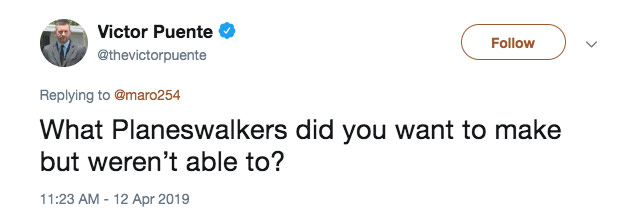
In vision design, we didn't worry about who made sense being on Ravnica, because we knew that it would get sorted out later, so we just put in all our favorites (well, other than the dead ones). So, if there's a Planeswalker character that you really wanted but we weren't able to include here, there's a chance that they were in the set, at least for a little while.
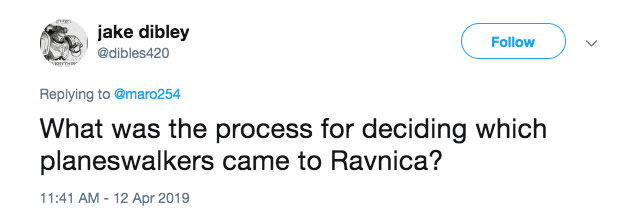
It was balance between color needs and story needs. The uncommons needed two of each monocolor and one of each two-color pair for the hybrid cycle. Other than that mechanical constraint, it was all decided by the Creative team and what worked for the story.
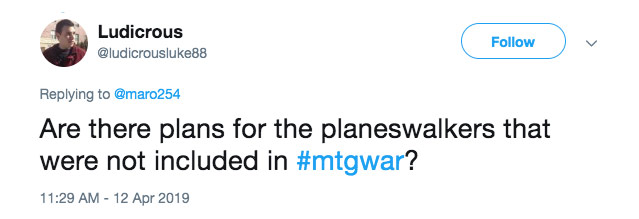
One of the major reasons certain Planeswalkers didn't show up in War of the Spark is because we had plans for them elsewhere. There are a number of Planeswalkers missing from War of the Spark that should be showing up in the next few years.
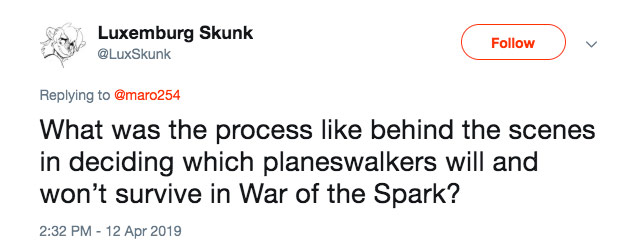
Who survived and who didn't survive was mostly decided by story needs. The only tiny impact that R&D might have had (and I'm not sure this had any impact) was about a year ago, when we mapped out how much design space each character had, meaning how many more planeswalker cards we think we could design for them.
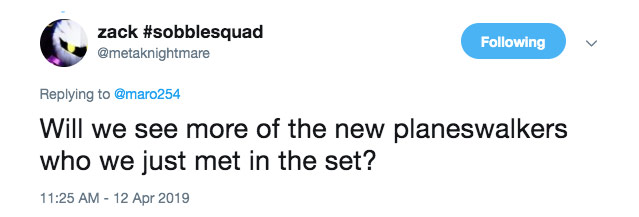
We definitely have plans for some of them. We'll also be monitoring what players think of the Planeswalkers in War of the Spark. The more fan appreciation any one Planeswalker gets, the greater the chance and speed of their return.
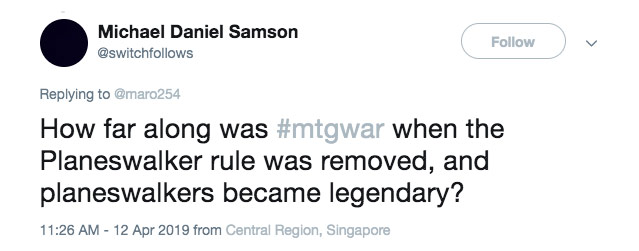
That change happened (on our end, not when we told all of you about it) before War of the Spark started vision design, so it had zero impact on how we made the set. We went in knowing the change had already happened.
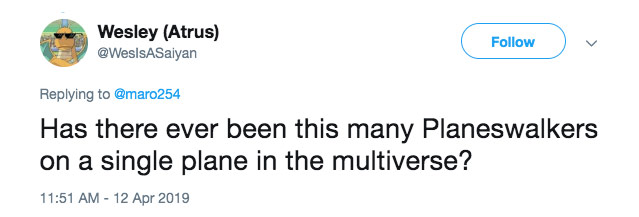
I think this is the record. Remember that there are a lot more Planeswalkers here than just the 37 that have cards (albeit, many unknown to the audience). This kind of gathering of Planeswalkers doesn't happen very often.
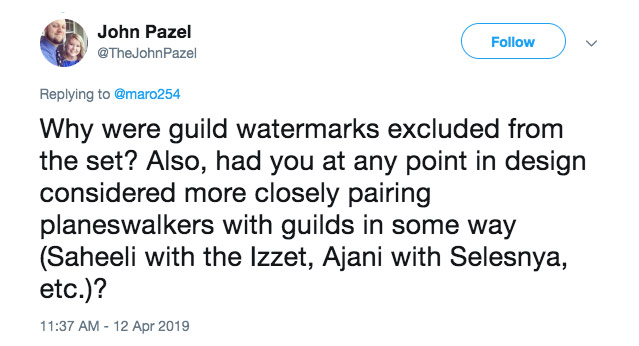
We didn't use watermarks because this isn't a guild set. It's not at all about the guilds, so it felt wrong to label them as such. In fact, this set is much more about the guilds coming together and being a cohesive Ravnica, so in that way, the guild watermarks would have worked against the feeling we were trying to create. Also, there were cards showing guilds teaming up with one another, and that would have made watermarks messy.
We did entertain the idea of having Team Bolas and Team Gatewatch watermarks as that's much more the factions that the set is built around, but there are a lot of parties that are neutral or ambiguous and we thought it was cooler not knowing exactly who was on what side as it added a bit to the chaos of the war.
Because this isn't a guild set, we actively tried to avoid thinking in guild cycles, so the idea of linking planeswalkers with guilds just felt out of place. War of the Spark, in general, played a lot in the space of being on Ravnica, but not being a guild set, so we were disincentive to play up the guilds.
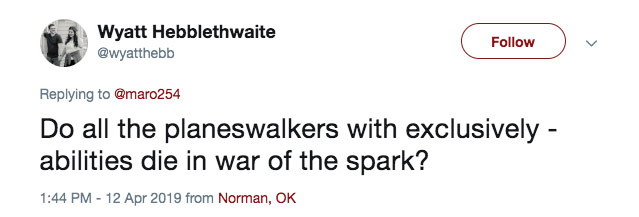
No, they did not. Note that a planeswalker running out of loyalty does not represent the Planeswalker dying, but rather running out of a desire to help you anymore. In general, positive-loyalty abilities represent something easy and fun for them to do, so they enjoy it and want to stick around. Negative-loyalty abilities represent a more difficult task that takes energy, increasing their desire to planeswalk away.
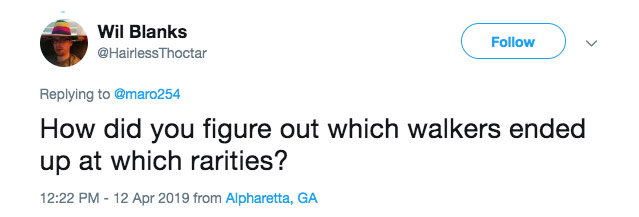
The main protagonists and antagonists got to be mythic rare. The rest of the Gatewatch was rare. The other planeswalkers' rarity placement was based on their design. If it could be hybrid, it was uncommon, and if it wanted to be a traditional two-color gold card, it had to be rare. Color dictated some slots (Vraska, for example, was the only black-green planeswalker in the set and thus had to be hybrid) as did slot placement (ten cards had to be monocolor uncommons), but mostly it was based on what rarity the best design for each planeswalker felt most suited.
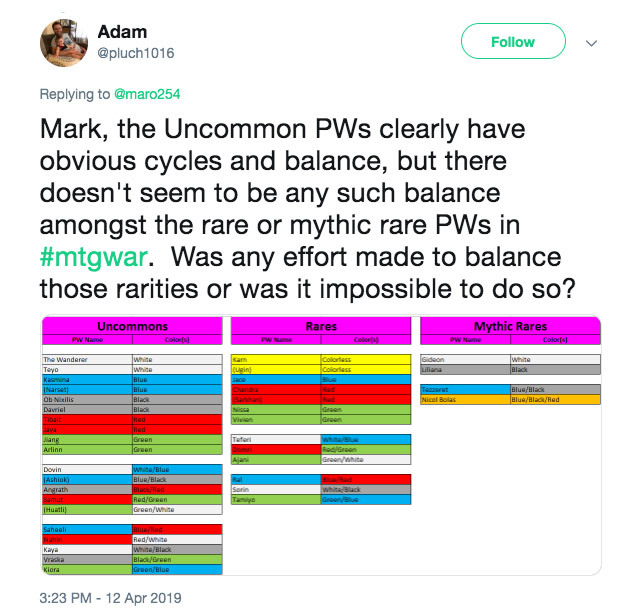
In all sets, we balance color at uncommon because color balance is important for making Limited work. At rare and mythic rare, we roughly color balance, but being exact isn't as important, so we allow other factors (such as character choice for Planeswalkers in War of the Spark) to dictate our decisions.
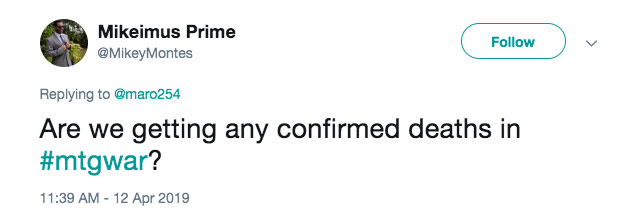
Yes, you are. Three named Planeswalkers (aka ones that have previously had a card) died in War of the Spark. To avoid spoiling the story for readers who don't want to know, you'll have to click below to learn who died.
Click here to see who died
Gideon Jura, Domri Rade, and Dack Fayden all died in War of the Spark.
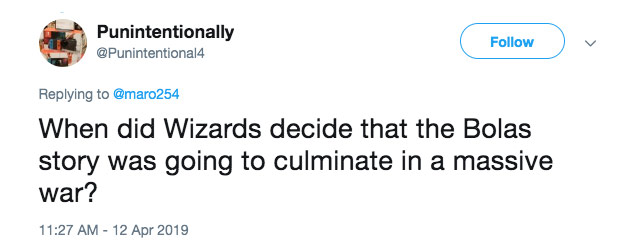
When Doug first proposed the Bolas Arc many, many years ago, the story, culminating in a giant Planeswalker war, was a part of it—so from the very beginning. My first response, incidentally, was, "That sounds like a cool story, but I don't know how we make a set out of it."
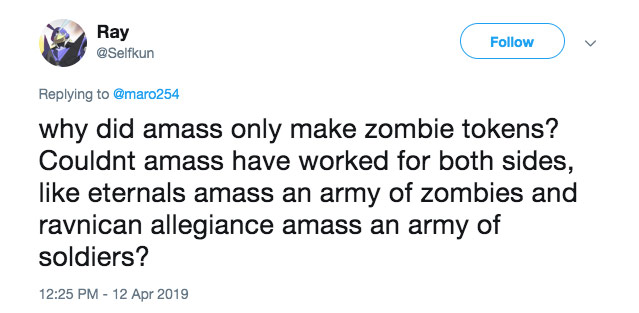
That would have conveyed that the two sides were just mirrors of each other, and that's not at all how we wanted to set up the conflict. Also, we wanted to limit amass to certain colors (blue, black, and red), which attaching it to Bolas's Dreadhorde army allowed us to do.
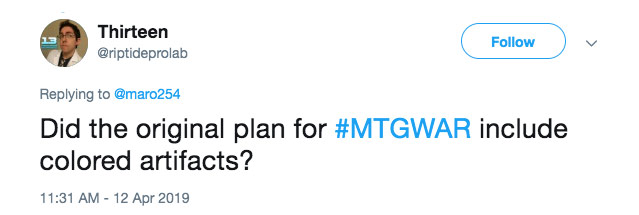
Ever since we had to ban a bunch of cards from Kaladesh block, we realized we had to rethink how we design artifacts. The option was to stop pushing them for Constructed or start incorporating colored mana. We chose the latter as artifacts are popular and flavorful. Many artifacts already push creatively toward a certain color, so the adoption of colored mana when needed didn't feel like too much of a sacrifice. In other words, we knew going into War of the Spark that we'd have some colored artifacts.
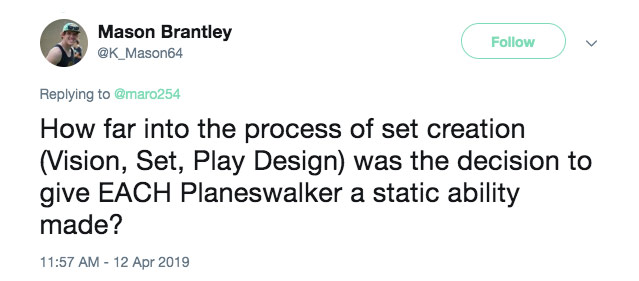
Vision Design decided that we'd include them in the set. When we handed off the file to Set Design, all the rares and mythic rares had a static or triggered ability. The uncommons, at the time (to lessen complexity), all had one ability, either a negative-loyalty ability or a static/triggered ability. Set Design made the decision to make every uncommon both have a static/triggered ability and a negative-loyalty ability as they felt it helped them feel more planeswalker-ish. It was decided that the uncommon planeswalkers just being a bit more complex was acceptable as it was so key to the theme of the set.
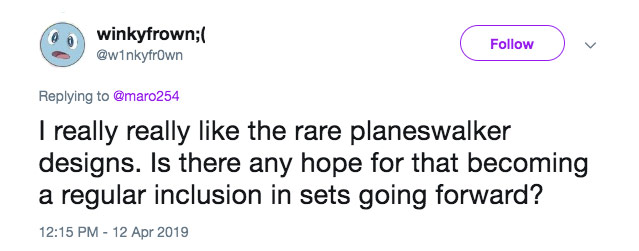
It's a tool in our toolbox available to future design teams. The plan is for planeswalkers to be mythic rare by default, but if a design team feels that a rare (or uncommon) planeswalker would serve the set, they have access to it.

Next up is Modern Horizons, which is a different kind of set than War of the Spark, but should generate a similar level of excitement. One of our new hire's first day was the Modern Horizons slide show, and with a giant smile on their face after seeing it, their response to me was, "How in the world did you get that set made?" Core Set 2020 takes what the players liked about Core Set 2019, ups the excitement level, and adds some things you all might not expect. Finally (well for booster products), is "Archery" (that's a codename), the fall set that I've been trying to get made for over a decade. I smile every time I think about it. And I believe you all will as well once you've seen it. So, fear not, we're not resting on our laurels. 2019 is going to be an amazing year for Magic.
War Correspondence
That's all the time I have for today. Thanks to everyone who sent me a question. As always, I'm eager to hear your feedback on today's column, any of my answers, or War of the Spark itself. You can email me or contact me through any of my social media accounts (Twitter, Tumblr, and Instagram).
Join me next week when Modern Horizons previews begin.
Until then, may you keep asking interesting questions.
#635: Rabiah Scale, Part 2
#635: Rabiah Scale, Part 2
38:56
This is part two of a two-part series exploring the Rabiah Scale, a scale talking about how likely we are to visit or revisit certain planes in a Standard-legal set.
#636: Rise & Fall of the Blocks
#636: Rise & Fall of the Blocks
41:21
This podcast is about the history of the block, how they came about and why they went away.
- Episode 634 Rabiah Scale, Part 1
- Episode 633 Morningtide, Part 3
- Episode 632 Morningtide, Part 2


</p>%0A%0A<em>War%20of%20the%20Spark</em>%20is%20the%20end%20of%20the%20Bolas%20Arc.%20<em>Magic</em>%20has%20an%20ongoing%20narrative%20story,%20so%20elements%20of%20things%20that%20happened%20in%20the%20past%20will%20matter%20in%20the%20future,%20but%20October's%20set%20has%20a%20story%20that%20has%20nothing%20directly%20to%20do%20with%20Bolas%20or%20the%20Gatewatch.</p>%0A%0A<hr%20/>%0A%0A<p%20class=)